The United States Armed Forces are the military forces of the United States. The armed forces consists of six service branches: the Army, Marine Corps, Navy, Air Force, Space Force, and Coast Guard. All six armed services are among the eight uniformed services of the United States.

The Joint Chiefs of Staff (JCS) is the body of the most senior uniformed leaders within the United States Department of Defense, which advises the president of the United States, the secretary of defense, the Homeland Security Council and the National Security Council on military matters. The composition of the Joint Chiefs of Staff is defined by statute and consists of a chairman (CJCS), a vice chairman (VJCS), the chiefs of the Army, Marine Corps, Navy, Air Force, Space Force, and the chief of the National Guard Bureau. Each of the individual service chiefs, outside their JCS obligations, works directly under the secretaries of their respective military departments, e.g. the secretary of the Army, the secretary of the Navy, and the secretary of the Air Force.

The Goldwater–Nichols Department of Defense Reorganization Act of October 4, 1986 made the most sweeping changes to the United States Department of Defense since the department was established in the National Security Act of 1947 by reworking the command structure of the U.S. military. It increased the powers of the chairman of the Joint Chiefs of Staff and implemented some of the suggestions from the Packard Commission, commissioned by President Reagan in 1985. Among other changes, Goldwater–Nichols streamlined the military chain of command, which now runs from the president through the secretary of defense directly to combatant commanders, bypassing the service chiefs. The service chiefs were assigned to an advisory role to the president and the secretary of defense, and given the responsibility for training and equipping personnel for the unified combatant commands.

The United States Space Command is a unified combatant command of the United States Department of Defense, responsible for military operations in outer space, specifically all operations 100 kilometers and greater above mean sea level. U.S. Space Command is responsible for the operational employment of space forces that are provided by the uniformed services of the Department of Defense.

The United States Strategic Command (USSTRATCOM) is one of the eleven unified combatant commands in the United States Department of Defense. Headquartered at Offutt Air Force Base, Nebraska, USSTRATCOM is responsible for strategic nuclear deterrence, global strike, and operating the Defense Department's Global Information Grid. It also provides a host of capabilities to support the other combatant commands, including integrated missile defense; and global command, control, communications, computers, intelligence, surveillance, and reconnaissance (C4ISR). This command exists to give "national leadership a unified resource for greater understanding of specific threats around the world and the means to respond to those threats rapidly".
A unified combatant command, also referred to as a combatant command (CCMD), is a joint military command of the United States Department of Defense that is composed of units from two or more service branches of the United States Armed Forces, and conducts broad and continuing missions. There are currently 11 unified combatant commands, and each is established as the highest echelon of military commands, in order to provide effective command and control of all U.S. military forces, regardless of branch of service, during peace or during war time. Unified combatant commands are organized either on a geographical basis or on a functional basis, e.g., special operations, force projection, transport, and cybersecurity. Currently, seven combatant commands are designated as geographical, and four are designated as functional. Unified combatant commands are "joint" commands and have specific badges denoting their affiliation.
Joint Task Force-Global Network Operations (JTF-GNO) was a subordinate command of United States Strategic Command whose mission was to: direct the operation and defense of the Global Information Grid (GIG) across strategic, operational, and tactical boundaries in support of the US Department of Defense's full spectrum of war fighting, intelligence, and business operations.

Joint Functional Component Command for Integrated Missile Defense is a component of United States Space Command (USSPACECOM). The current commander is Army Lieutenant General Daniel L. Karbler.
The Joint Functional Component Command for Intelligence, Surveillance and Reconnaissance was a subordinate command of the United States Strategic Command, one of the nine Unified Combatant Commands under the United States Department of Defense (DOD) and co-located with the Defense Intelligence Agency (DIA). It served as the center for planning, execution, and assessment of the United States military's global Intelligence, Surveillance, and Reconnaissance operations from 2005-2016; a key enabler in achieving global situational awareness. In 2016 JFCC-ISR was realigned to the Joint Staff.
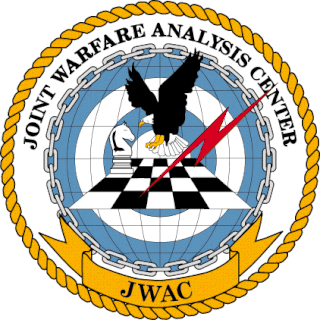
Joint Warfare Analysis Center (JWAC) is a subordinate command of United States Strategic Command (USSTRATCOM) that contributes to United States national security by recommending strategic technical solutions. JWAC has evolved from a small program office into a joint command of more than 400 personnel. As it grew, it became part of the Joint Chiefs of Staff in 1994 and then was spun off as an independent joint command subordinate to United States Joint Forces Command in 1998.

Command and control is a "set of organizational and technical attributes and processes ... [that] employs human, physical, and information resources to solve problems and accomplish missions" to achieve the goals of an organization or enterprise, according to a 2015 definition by military scientists Marius Vassiliou, David S. Alberts, and Jonathan R. Agre. The term often refers to a military system.

The United States Department of Defense is an executive branch department of the federal government of the United States charged with coordinating and supervising all agencies and functions of the U.S. government directly related to national security and the United States Armed Forces. As of June 2022, the U.S. Department of Defense is the largest employer in the world, with over 1.34 million active-duty service members, including soldiers, marines, sailors, airmen, and guardians. The Department of Defense also maintains over 778,000 National Guard and reservists, and over 747,000 civilians bringing the total to over 2.87 million employees. Headquartered at the Pentagon in Arlington County, Virginia, just outside Washington, D.C., the Department of Defense's stated mission is to provide "the military forces needed to deter war and ensure our nation's security".
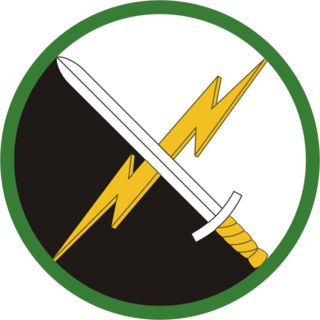
The 1st Information Operations Command (Land), formerly the Land Information Warfare Activity Information Dominance Center (LIWA/IDC), is an information operations unit under the operational control of U.S. Army Cyber Command (ARCYBER) and headquartered at Fort Belvoir, Virginia.

The United States Air Force's 119th Command and Control Squadron is a space control unit located at McGhee Tyson ANGB, Tennessee. The unit augments the operations of USSTRATCOM on a continuous basis.
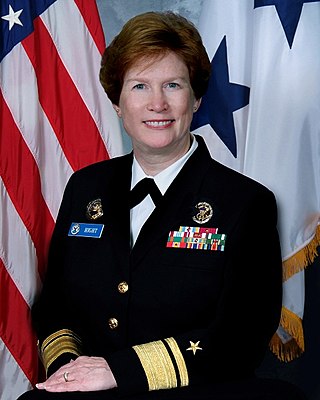
Elizabeth Ann Hight is a retired United States Navy rear admiral who served as the vice director of the Defense Information Systems Agency (DISA). She assumed this post in December 2007. In 2008, she was nominated for appointment to the grade of vice admiral and assignment as director, Defense Information Systems Agency; commander, Joint Task Force – Global Network Operations; and deputy commander, U.S. Strategic Command Global Network Operations and Defense, Arlington, Virginia. Her nomination was rejected by the Senate due to a perceived conflict of interest with her husband, retired Air Force Brigadier General Gary Salisbury, who is vice president of business development and sales for Northrop Grumman Corp.'s mission systems sector, defense mission systems division. She retired from the Navy in 2010.
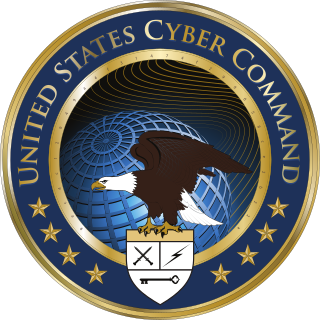
United States Cyber Command (USCYBERCOM) is one of the eleven unified combatant commands of the United States Department of Defense (DoD). It unifies the direction of cyberspace operations, strengthens DoD cyberspace capabilities, and integrates and bolsters DoD's cyber expertise which focus on securing cyberspace.
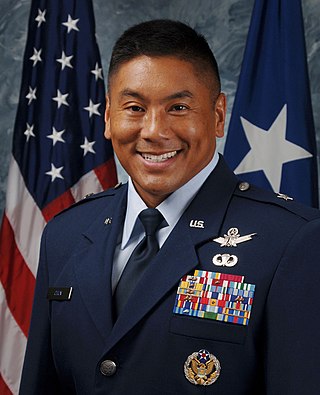
Brigadier General Cary C. Chun is a retired senior officer of the United States Air Force. He served as the Deputy Commander, Operations and Interagency Integration, Joint Functional Component Command for Space, United States Strategic Command (USSTRATCOM), and the Director for Mission Operations, National Reconnaissance Office. In this role, he led all Department of Defense space forces aligned with USSTRATCOM and provided tailored, responsive, local and global effects in support of national, USSTRATCOM and combatant commander objectives. As Director for Mission Operations, he led operations for all NRO overhead reconnaissance systems, ground stations, operational communications, and the operations center used to conduct intelligence activities essential for the national security of the United States and its allies.

The U.S. Fleet Cyber Command is an operating force of the United States Navy responsible for the Navy's information network operations, offensive and defensive cyber operations, space operations and signals intelligence. It was created in January 2010 "to deter and defeat aggression and to ensure freedom of action to achieve military objectives in and through cyberspace". U.S. Tenth Fleet was simultaneously reactivated as its force provider. Since it was founded, the command has grown into an operational force composed of more than 16,000 active and reserve sailors and civilians organized into 27 active commands, 40 Cyber Mission Force units, and 27 reserve commands around the world.
Information Operations is a category of direct and indirect support operations for the United States Military. By definition in Joint Publication 3-13, "IO are described as the integrated employment of electronic warfare (EW), computer network operations (CNO), psychological operations (PSYOP), military deception (MILDEC), and operations security (OPSEC), in concert with specified supporting and related capabilities, to Information Operations (IO) are actions taken to affect adversary information and information systems while defending one's own information and information systems.














